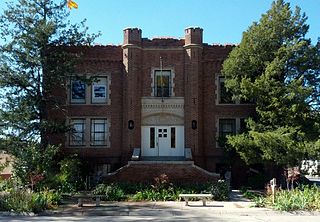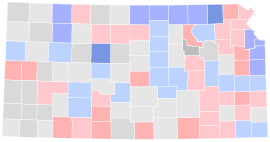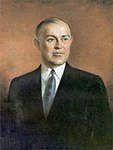
Presidential elections were held in the United States on November 3, 1936. In the midst of the Great Depression, incumbent Democratic President Franklin D. Roosevelt defeated Republican governor Alf Landon of Kansas in a landslide victory. Roosevelt won the highest share of the popular vote (60.8%) and the electoral vote since the largely uncontested 1820 election. The sweeping victory consolidated the New Deal Coalition in control of the Fifth Party System.

Kit Carson County is a county located in the U.S. state of Colorado. As of the 2020 census, the population was 7,087. The county seat is Burlington. The county was established in 1889 and named for American frontiersman and Indian fighter Kit Carson.

Alfred Mossman Landon was an American oilman and politician who served as the 26th governor of Kansas from 1933 to 1937. A member of the Republican Party, he was the party's nominee in the 1936 presidential election, and was defeated in a landslide by incumbent president Franklin D. Roosevelt. The margin of victory in the electoral college was the largest of Roosevelt's four elections to the office of president, as Landon won just 8 electoral votes to Roosevelt's 523. Landon died on October 12, 1987, becoming the only presidential candidate from either of the major parties to live to the age of 100 until Jimmy Carter in 2024, and is to date the only Republican candidate to do so.

Harry Hines Woodring was an American politician. A Democrat, he was the 25th Governor of Kansas and the United States Assistant Secretary of War from 1933 to 1936. His most important role was Secretary of War in President Franklin Delano Roosevelt's cabinet from 1936 to 1940. After 1938, Roosevelt rejected isolationism regarding Europe. Woodring quietly opposed Roosevelt and was eventually fired.

John Romulus Brinkley was an American quack doctor, broadcaster, marketer and independent politician. He had no accredited education as a physician and bought his medical degree from a diploma mill. Brinkley became known as the "goat-gland doctor" after he achieved national fame, international notoriety, and wealth through the xenotransplantation of goat testicles into humans. Although initially Brinkley promoted this procedure as a means of curing male impotence, he later claimed that the technique was a virtual panacea for a wide range of male ailments. Brinkley operated clinics and hospitals in several states and was able to continue practicing medicine for almost two decades despite his techniques being thoroughly discredited by the broader medical community.

The Kansas Republican Party is the state affiliate political party in Kansas of the United States Republican Party. The Kansas Republican Party was organized in May 1859.

Walter Augustus Huxman was an American attorney, politician, and jurist who served as the 27th governor of Kansas and a United States circuit judge of the United States Court of Appeals for the Tenth Circuit.

The 1936 United States elections were held on November 3, 1936, during the Great Depression. Democratic President Franklin D. Roosevelt trounced Governor Alf Landon of Kansas in a landslide and the Democrats built on their majorities in both chambers of Congress.

The 1936 United States presidential election in Vermont took place on November 3, 1936, as part of the 1936 United States presidential election which was held throughout all contemporary 48 states. Voters chose three representatives, or electors to the Electoral College, who voted for president and vice president.

The 1936 United States presidential election in Minnesota took place on November 3, 1936, as part of the 1936 United States presidential election. Voters chose 11 electors, or representatives to the Electoral College, who voted for president and vice president.

The 1946 Kansas gubernatorial election was held on November 5, 1946. Republican nominee Frank Carlson defeated Democratic nominee Harry Hines Woodring with 53.50% of the vote.

The 1930 Kansas gubernatorial election took place on November 4, 1930. Harry H. Woodring was elected Governor of Kansas, becoming only the fourth member of the Democratic Party to hold the position in state history. He won with only 34.96% of the vote, with the remainder being split between Republican candidate Frank Haucke and independent write-in candidate John R. Brinkley. Woodring's final margin of victory over Haucke was just 251 votes, or 0.04 percent. The incumbent governor, Republican Clyde M. Reed, was defeated for renomination.

The 1936 United States presidential election in Maine was held on November 3, 1936 as part of the 1936 United States presidential election. The state voters chose five electors to the Electoral College, who voted for president and vice president.

The 1936 United States presidential election in Kansas took place on November 3, 1936, as part of 1936 United States presidential election held in all forty-eight contemporary states. Kansas voters chose nine electors, or representatives to the Electoral College, who voted for President and Vice President.

The 1936 United States presidential election in Alabama took place on November 3, 1936, as part of the nationwide presidential election. Voters chose eleven representatives, or electors to the Electoral College, who voted for president and vice president. In Alabama, voters voted for electors individually instead of as a slate, as in the other states.

The 1936 United States presidential election in Texas took place on November 3, 1936, as part of the 1936 United States presidential election. Texas voters chose 23 representatives, or electors, to the Electoral College, who voted for president and vice president.

The 1936 United States presidential election in Tennessee took place on November 3, 1936, as part of the 1936 United States presidential election. Tennessee voters chose 11 representatives, or electors, to the Electoral College, who voted for president and vice president.

The 1936 United States presidential election in Oregon took place on November 3, 1936, as part of the 1936 United States presidential election. Voters chose five representatives, or electors, to the Electoral College, who voted for president and vice president.

The 1936 United States presidential election in North Carolina took place on November 3, 1936, as part of the 1936 United States presidential election. North Carolina voters chose 13 representatives, or electors, to the Electoral College, who voted for president and vice president.

The 1934 Kansas gubernatorial election was held on November 6, 1934. Incumbent Republican Alf Landon defeated Democratic nominee Omar B. Ketchum with 53.51% of the vote.























